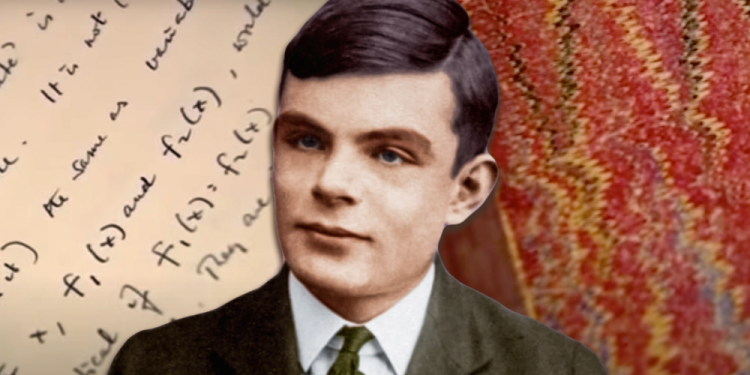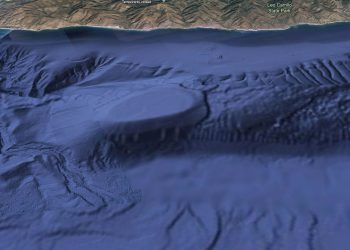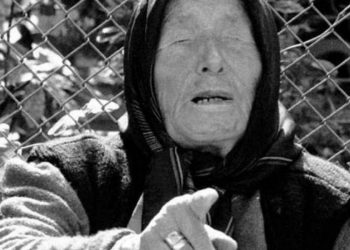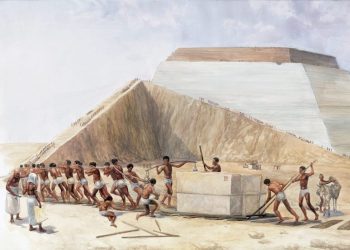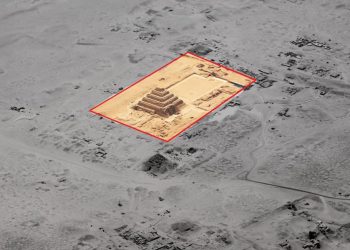Alan Turing is famous today, heralded as the father of modern computing and artificial intelligence. Many people are familiar with Turing’s life, as seen in the 2014 movie, The Imitation Game, in which actor Benedict Cumberbatch plays Turing.
Alan Turing’s Secret Manuscript
Despite his fame and historical importance now, he left behind a few handwritten manuscripts. He called one such manuscript “Notes on Notations,” written in a composition notebook. In April 2015, it was the only Turing manuscript to go up for public auction, fetching $1,025,000 from a private buyer in New York.
What did Turing’s Secret Manuscript contain? We’ll look at the ten things you should know.
First, a brief background on Alan Turing:
Who Was Alan Turing?
A brilliant British mathemetician, Alan Turing’s work as a code breaker during World War II helped the Allies win the war against the Axis powers and the Nazis. Before the war began, he was already working the top-secret Government Code and Cipher School at Bletchley Park. By 1945, he played a leading role in a team of more than 8,000 people.
Without Turing’s unique mind, the outcome of World War II could have been entirely different.
Notably, the work at Bletchley Park only became public knowledge in the 1970s.
Breaking Enigma with The Bombe
Turing designed an electromechanical machine called the Bombe. Then, Bletchley Park deployed hundreds of the famous wartime machines to crack the German Enigma code, encrypted messages sent via Morse code.
Consequently, the Allies could decipher the German’s secret messages toward the end of the war. Critically, it was Turin’s work that gave them an enormous advantage. By deciphering secret messages, they knew the German’s plans and their vulnerabilities.
Notably, Turing’s team also designed and developed Colossus, one of the first programmable computers. However, after the war, Prime Minister Winston Churchill ordered the ten Colossi and 200 of the Bombe machines destroyed. Reportedly, he feared they would fall into the hands of the former Soviet Union.
Decisive Victory for the Allies
In 2016, a letter written by the supreme commander of the Allied Expeditionary Force, Dwight D Eisenhower, went on public display at Bletchley Park. In the letter, Eisenhower wrote that Bletchley Park’s efforts had been “priceless,” saving thousands of British and American lives and bringing the war to a faster end.
According to other reports, Turing’s efforts may have shortened the war by two or more years. Today, documents from Turing’s years at Bletchley Park remain secret, still valuable in the ongoing fight against terrorism.
Alan Turing’s Secret Manuscript – 10 Things You Should Know
- Turing’s yellowing composition notebook, entitled “Notes on Notations,” contained 39 pages of his handwriting from around 1942. Some reports say there are 56 pages. It was written at the time of Turing’s wartime efforts to break the Enigma code. Turing may have purchased the notebook at Metcalfe and Son, across from his room at King’s College in Cambridge.
- Until it went on loan to Bletchley Park in 2017, not even Turing scholars had seen what it contained. Now, we know it contains a sometimes scathing commentary on the notational practices of famous mathematicians: Courant, Eisenhart, Hilbert, Peano, Titchmarsh, Weyl, and others. It had no connection to his wartime efforts or personal life.
- On one page, he says a notation by Leibniz is particularly vexing, writing, “The Leibniz notation I find extremely difficult to understand in spite of it having been the one I understood the best once! It certainly implies that some relation between x and y has been laid down eg, y=x2+3x…”
- In his notebook, Turing didn’t hold back in criticizing the work of famous mathematicians’ notations, writing remarks like “I don’t like this,” “ugly,” “somewhat to be deplored,” or “rather abortive.” Turing biographer Jack Copeland noted that this “blunt candor” isn’t found in Turing’s other writings.
- Sir Dermot Turing told the BBC that the manuscript “revealed his uncle had a sense of humor and was not a total geek.'” Sir Dermot also said that the text showed his uncle considered mathematics his “real profession” and considered codebreaking “a sort of fun pursuit,” or hobby.
- At the same time that Turing was working to intercept the German’s messages, he was focused on reforming mathematical notations, which he believed could “handicap” mathematics. He hoped to improve what he considered “exceedingly unsystematic” methods by investigating and examining current mathematical notations.
- Turing’s notebook builds on his wartime typescript called “The Reform of Mathematical Notation and Phraseology,” which has annotations by his student, annotations, and notes by R.O. Gandy. It is publically viewable in the Turing Archive, directed by Jack Copeland.
- Ahead of his time, Turing hoped to reform the “theory of types,” or type theory, which is now commonly part of computer programming languages. If he had lived, who knows how much more advanced computing would be today?
- In 2015, Turin’s manuscript sold for $1,025,000 (£698,000) in a sale by Bonham’s auction house. The buyer remains anonymous. Before then, Robin Gandy, Turin’s student, friend, and fellow mathematician, kept the notebook until he died in 1995. Turing had bequeathed his mathematical books and papers to Gandy. It remains unclear where Turing’s manuscript went after Gandy’s death.
- In the middle of the Turing manuscript, Gandy wrote personal notes about his relationship with Turing on the blank pages. Reportedly, the Manchester University professor of logic stayed with Turing just days before his suicide on June 7, 1954. He insisted they were not lovers.
See more from IBTimes UK:
Alan Turing’s Last Days and Posthumous Pardon
In 1946, King George VI recognized Alan Turing as an Officer of the Order of the British Empire (OBE) for his critically important work. Nevertheless, Turing died as a criminal soon after in 1954. It was just before his 42nd birthday.
Sadly, Victorian laws convicted Turing as a homosexual after he admitted to attempting a relationship with a man. As punishment, he was forced to endure chemical castration, injected with female sex hormones to avoid prison time. Also, the government stripped him of his security clearance.
His apparent suicide involved biting into an apple laced with cyanide. However, there is speculation that his death may not have been intentional. One theory holds that British Security Services considered him a high risk because he was gay.
Also, there is a story that Apple designed their logo to honor Turing, but the designer Rob Janoff, says it’s a “wonderful urban legend.”
In 2017, Queen Elizabeth II posthumously pardoned Alan Turing, which Justice Minister Chris Grayling called a fitting tribute to “an exceptional man with a brilliant mind.” That same year, a law informally named after Turing pardoned all men convicted based on their sexuality.
In March 2021, the Bank of England unveiled a new £50 note featuring Alan Turing’s portrait. Then, it officially entered circulation on June 23, Turing’s birthday. The new polymer note contains a mathematical table and formula from Turing’s 1936 paper “On Computable Numbers,” and other symbols.
Join the discussion and participate in awesome giveaways in our mobile Telegram group. Join Curiosmos on Telegram Today. t.me/Curiosmos



